Bichop R.H. (Ed.) Mechatronic Systems, Sensors, and Actuators: Fundamentals and Modeling
Подождите немного. Документ загружается.

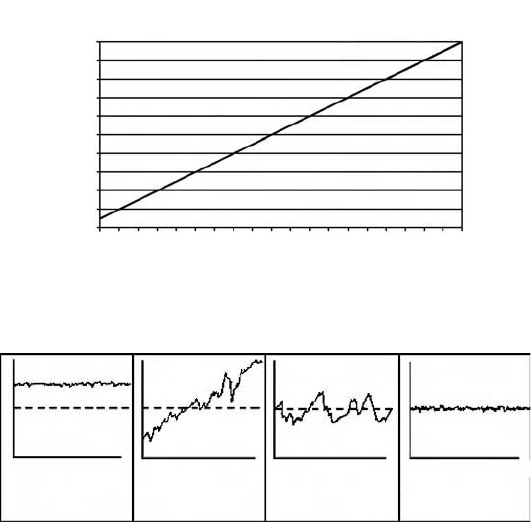
18-6 Mechatronic Systems, Sensors, and Actuators
Dimensionless frequency offset values can be converted to units of frequency (Hz) if the nominal
frequency is known. To illustrate this, consider an oscillator with a nominal frequency of 5 MHz and a
frequency offset of +1.16 × 10
−11
. To find the frequency offset in hertz, multiply the nominal frequency
by the offset:
(5 × 10
6
) (+1.16 × 10
−11
) = 5.80 × 10
−5
= +0.0000580 Hz
Then, add the offset to the nominal frequency to get the actual frequency:
5,000,000 Hz + 0.0000580 Hz = 5,000,000.0000580 Hz
18.2.2 Stability
Stability indicates how well an oscillator can produce the same time or frequency offset over a given time
interval. It doesn’t indicate whether the time or frequency is “right” or “wrong,” but only whether it stays
the same. In contrast, accuracy indicates how well an oscillator has been set on time or on frequency. To
understand this difference, consider that a stable oscillator that needs adjustment might produce a
frequency with a large offset. Or, an unstable oscillator that was just adjusted might temporarily produce
a frequency near its nominal value. Figure 18.7 shows the relationship between accuracy and stability.
Stability is defined as the statistical estimate of the frequency or time fluctuations of a signal over a
given time interval. These fluctuations are measured with respect to a mean frequency or time offset.
Short-term stability usually refers to fluctuations over intervals less than 100 s. Long-term stability can
refer to measurement intervals greater than 100 s, but usually refers to periods longer than 1 day.
Stability estimates can be made in either the frequency domain or time domain, and can be calculated
from a set of either frequency offset or time interval measurements. In some fields of measurement,
stability is estimated by taking the standard deviation of the data set. However, standard deviation only
FIGURE 18.6 A sample phase plot.
FIGURE 18.7 The relationship between accuracy and stability.
1
0
2
2
Time (seconds)
Quartz oscillator with 1× 10
–9
frequency offset
Phase (nanoseconds)
34
4
56
6
78
8
910
10
11 12
12
13 14
14
15 16
16
17 18
18
19 20
20
f
fo
Time
Stable and
accurate
Accurate but
not stable
Not stable and
not accurate
Stable but
not accurate
Time Time Time
fff
9258_C018.fm Page 6 Tuesday, October 2, 2007 1:22 AM
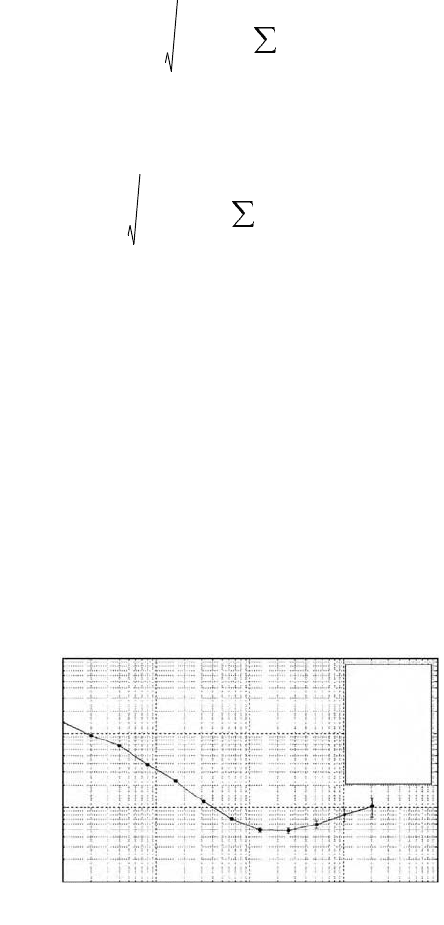
Fundamentals of Time and Frequency 18-7
works with stationary data, where the results are time independent, and the noise is white, meaning that
it is evenly distributed across the frequency band of the measurement. Oscillator data is usually nonsta-
tionary, since it contains time dependent noise contributed by the frequency offset. With stationary data,
the mean and standard deviation will converge to particular values as more measurements are made.
With nonstationary data, the mean and standard deviation never converge to any particular values.
Instead, there is a moving mean that changes each time we add a measurement.
For these reasons, a non-classical statistic is often used to estimate stability in the time domain. This
statistic is sometimes called the Allan variance, but since it is the square root of the variance, its proper
name is the Allan deviation. The equation for the Allan deviation (
σ
y
(
τ
)) is
where y
i
is a set of frequency offset measurements containing y
1
, y
2
, y
3
, and so on, M is the number of
values in the y
i
series, and the data are equally spaced in segments
τ
seconds long. Or
where x
i
is a set of phase measurements in time units containing x
1
, x
2
, x
3
, and so on, N is the number
of values in the x
i
series, and the data are equally spaced in segments
τ
seconds long. Note that while
standard deviation subtracts the mean from each measurement before squaring their summation, the
Allan deviation subtracts the previous data point. This differencing of successive data points removes
the time dependent noise contributed by the frequency offset.
An Allan deviation graph is shown in Figure 18.8. It shows the stability of the device improving as
the averaging period (
τ
) gets longer, since some noise types can be removed by averaging. At some point,
however, more averaging no longer improves the results. This point is called the noise floor, or the point
where the remaining noise consists of nonstationary processes such as flicker noise or random walk. The
device measured in Figure 18.8 has a noise floor of ∼5 × 10
−11
at
τ
= 100 s.
Practically speaking, a frequency stability graph also tells us how long we need to average to get rid of
the noise contributed by the reference and the measurement system. The noise floor provides some
indication of the amount of averaging required to obtain a TUR high enough to show us the true frequency
FIGURE 18.8 A frequency stability graph.
σ
y
τ
()
1
2 M 1–()
----------------------
y
i+1
y
i
–()
2
i=1
M−1
=
σ
y
τ
()
1
2 N 2–()
τ
2
--------------------------
x
i+2
2x
i+1
x
i
+–[]
2
i=1
N−2
=
10
0
10
–8
10
–9
10
–10
10
–11
10
1
10
2
Averaging time, , seconds
10
3
10
4
Tau (s)
1
2
4
8
16
32
64
128
256
512
1024
2048
Sigma
1.39e-09
9.41e-10
6.76e-10
3.82e-10
2.27e-10
1.20e-10
7.06e-11
4.94e-11
4.87e-11
5.90e-11
8.07e-11
1.04e-10
τ
Allan deviation,
y
( )
σ
τ
9258_C018.fm Page 7 Tuesday, October 2, 2007 1:22 AM
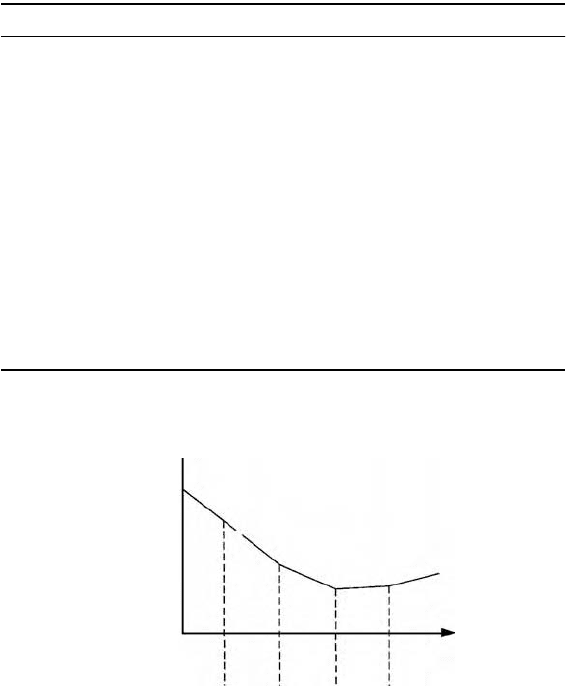
18-8 Mechatronic Systems, Sensors, and Actuators
offset of the DUT. If the DUT is an atomic oscillator (section 18.4) and the reference is a radio controlled
transfer standard (section 18.5) we might have to average for 24 h or longer to have confidence in the
measurement result.
Five noise types are commonly discussed in the time and frequency literature: white phase, flicker phase,
white frequency, flicker frequency, and random walk frequency. The slope of the Allan deviation line can
help identify the amount of averaging needed to remove these noise types (Figure 18.9). The first type
of noise to be removed by averaging is phase noise, or the rapid, random fluctuations in the phase of the
signal. Ideally, only the device under test would contribute phase noise to the measurement, but in practice,
some phase noise from the measurement system and reference needs to be removed through averaging.
Note that the Allan deviation does not distinguish between white phase noise and flicker phase noise.
Table 18.2 shows several other statistics used to estimate stability and identify noise types for various
applications.
Identifying and eliminating sources of oscillator noise can be a complex subject, but plotting the first
order differences of a set of time domain measurements can provide a basic understanding of how noise
is removed by averaging. Figure 18.10 was made using a segment of the data from the stability graph in
Figure 18.8. It shows phase plots dominated by white phase noise (1 s averaging), white frequency noise
(64 s averages), flicker frequency noise (256 s averages), and random walk frequency (1024 s averages).
Note that the white phase noise plot has a 2 ns scale, and the other plots use a 100 ps scale [8–12].
TABLE 18.2 Statistics Used to Estimate Time and Frequency Stability
and Noise Types
Name Mathematical Notation Description
Allan deviation
σ
γ
(
τ
) Estimates frequency stability. Particularly
suited for intermediate- to long-term
measurements
Modified Allan
deviation
MOD
σ
γ
(
τ
) Estimates frequency stability. Unlike the
normal Allan deviation, it can
distinguish between white and flicker
phase noise, which makes it more
suitable for short-term stability
estimates
Time deviation
σ
x
(
τ
) Used to measure time stability. Clearly
identifies both white and flicker phase
noise, the noise types of most interest
when measuring time or phase
Total dev iat ion
σ
γ
, TOTAL
(
τ
) Estimates frequency stability. Particularly
suited for long-term estimates where
τ
exceeds 10% of the total data sample
FIGURE 18.9 Using a frequency stability graph to identify noise types.
Noise type:
White
phase
Random
walk freq.
Flicker
freq.
White
freq.
Flicker
phase
τ
τ
τ
τ
τ
σ
γ
(τ)
τ
–1
–1
–1/2
1/2
0
9258_C018.fm Page 8 Tuesday, October 2, 2007 1:22 AM
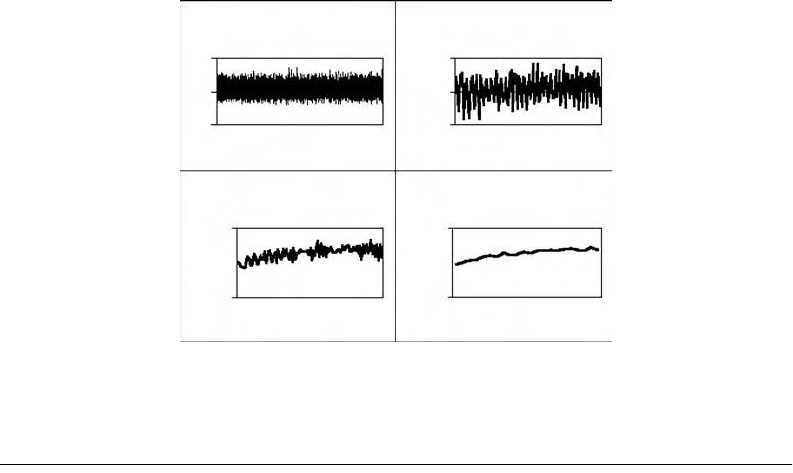
Fundamentals of Time and Frequency 18-9
18.3 Time and Frequency Standards
All time and frequency standards are based on a periodic event that repeats at a constant rate. The device
that produces this event is called a resonator. In the simple case of a pendulum clock, the pendulum is the
resonator. Of course, a resonator needs an energy source before it can move back and forth. Taken
together, the energy source and resonator form an oscillator. The oscillator runs at a rate called the
resonance frequency. For example, a clock’s pendulum can be set to swing back and forth at a rate of
once per second. Counting one complete swing of the pendulum produces a time interval of 1 s. Counting
the total number of swings creates a time scale that establishes longer time intervals, such as minutes,
hours, and days. The device that does the counting and displays or records the results is called a clock.
Table 18.3 shows how the frequency uncertainty of a clock’s resonator corresponds to the timing uncer-
tainty of a clock.
Throughout history, clock designers have searched for more stable resonators, and the evolution of
time and frequency standards is summarized in Table 18.4. The uncertainties listed for modern standards
represent current (year 2001) devices, and not the original prototypes. Note that the performance of
time and frequency standards has improved by 13 orders of magnitude in the past 700 years, and by
about nine orders of magnitude in the past 100 years.
The stability of time and frequency standards is closely related to their quality factor, or Q. The Q of
an oscillator is its resonance frequency divided by its resonance width. The resonance frequency is the
natural frequency of the oscillator. The resonance width is the range of possible frequencies where the
oscillator will oscillate. A high-Q resonator will not oscillate at all unless it is near its resonance frequency.
Obviously, a high resonance frequency and a narrow resonance width are both advantages when seeking
a high Q. Generally speaking, the higher the Q, the more stable the oscillator, since a high Q means that
an oscillator will stay close to its natural resonance frequency.
This section begins by discussing quartz oscillators, which achieve the highest Q of any mechanical-
type device. It then discusses oscillators with much higher Q factors, based on the atomic resonance of
rubidium and cesium. Atomic oscillators use the quantized energy levels in atoms and molecules as the
source of their resonance. The laws of quantum mechanics dictate that the energies of a bound system,
such as an atom, have certain discrete values. An electromagnetic field at a particular frequency can boost
an atom from one energy level to a higher one. Or, an atom at a high energy level can drop to a lower
level by emitting energy. The resonance frequency (f ) of an atomic oscillator is the difference between
FIGURE 18.10 Phase plots of four noise types.
White frequency noise
White phase noise
1 s data (no averaging)
64 s averages
1024 s averages256 s averages
8
9
7
8.048.04
8.14
8.04
8.14
8.14
8.09
Random walk frequency
Flicker frequency noice
9258_C018.fm Page 9 Tuesday, October 2, 2007 1:22 AM

18-10 Mechatronic Systems, Sensors, and Actuators
the two energy levels divided by Planck’s constant (h):
The principle underlying the atomic oscillator is that since all atoms of a specific element are identical,
they should produce exactly the same frequency when they absorb or release energy. In theory, the atom
is a perfect ‘‘pendulum’’ whose oscillations are counted to measure time interval. The discussion of atomic
oscillators is limited to devices that are commercially available, and excludes the primary and experimental
standards found in laboratories such as NIST. Table 18.5 provides a summary [1,4,8].
18.3.1 Quartz Oscillators
Quartz crystal oscillators are by far the most common time and frequency standards. An estimated two
billion (2 × 10
9
) quartz oscillators are manufactured annually. Most are small devices built for wrist-
watches, clocks, and electronic circuits. However, they are also found inside test and measurement
equipment, such as counters, signal generators, and oscilloscopes; and interestingly enough, inside every
atomic oscillator.
Table 18.3 Relationship of Frequency Uncertainty to Time Uncertainty
Frequency Uncertainty Measurement Period Time Uncertainty
±1.00 × 10
−3
1 s ± 1 ms
±1.00 × 10
−6
1 s ± 1
µ
s
±1.00 × 10
−9
1 s ± 1 ns
±2.78 × 10
−7
1 h ± 1 ms
±2.78 × 10
−10
1 h ± 1
µ
s
±2.78 × 10
−13
1 h ± 1 ns
±1.16 × 10
−8
1 day ± 1 ms
±1.16 × 10
−11
1 day ± 1
µ
s
±1.16 × 10
−14
1 day ± 1 ns
TABL E 18.4 Evolution of Time and Frequency Standards
Standard Resonator Date of Origin
Timing
Uncertainty (24 h)
Frequency
Uncertainty (24 h)
Sundial Apparent motion of
the sun
3500 BC NA NA
Verge escapement Verge and foliet
mechanism
14th century 15 min 1 × 10
−2
Pendulum Pendulum 1656 10 s 1 × 10
−4
Harrison
chronometer (H4)
Spring and balance
wheel
1759 350 ms 4 × 10
−6
Shortt pendulum Two pendulums,
slave and master
1921 10 ms 1 × 10
−7
Quartz crystal Quartz crystal 1927 10 µs1 × 10
−10
Rubidium gas cell
87
Rb resonance
(6,834,682,608 Hz)
1958 100 ns 1 × 10
−12
Cesium beam
133
Cs resonance
(9,192,631,770 Hz)
1952 1 ns 1 × 10
−14
Hydrogen maser Hydrogen resonance
(1,420,405,752 Hz)
1960 1 ns 1 × 10
−14
Cesium fountain
133
Cs resonance
(9,192,631,770 Hz)
1991 100 ps 1 × 10
−15
f
E
2
E
1
–
h
----------------
=
9258_C018.fm Page 10 Tuesday, October 2, 2007 1:22 AM
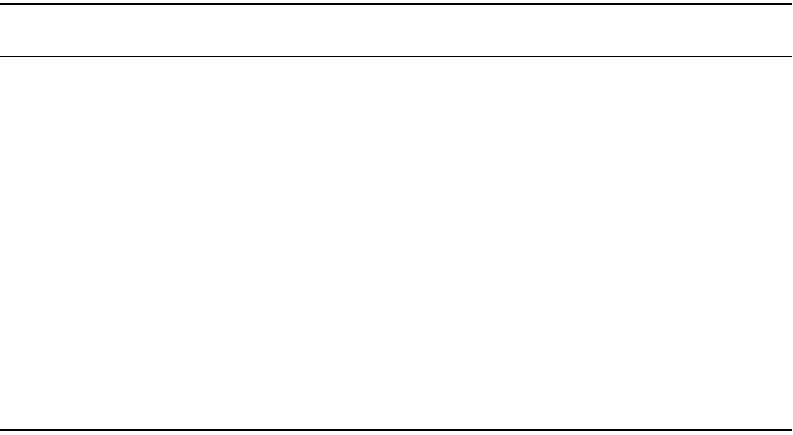
Fundamentals of Time and Frequency 18-11
A quartz crystal inside the oscillator is the resonator. It can be made of either natural or synthetic
quartz, but all modern devices use synthetic quartz. The crystal strains (expands or contracts) when a
voltage is applied. When the voltage is reversed, the strain is reversed. This is known as the piezoelectric
effect. Oscillation is sustained by taking a voltage signal from the resonator, amplifying it, and feeding it
back to the resonator. The rate of expansion and contraction is the resonance frequency and is determined
by the cut and size of the crystal. The output frequency of a quartz oscillator is either the fundamental
resonance or a multiple of the resonance, called an overtone frequency. Most high stability units use either
the third or fifth overtone to achieve a high Q. Overtones higher than fifth are rarely used because they
make it harder to tune the device to the desired frequency. A typical Q for a quartz oscillator ranges from
10
4
to 10
6
. The maximum Q for a high stability quartz oscillator can be estimated as Q = 1.6 × 10
7
/f,
where f is the resonance frequency in megahertz.
Environmental changes due to temperature, humidity, pressure, and vibration can change the reso-
nance frequency of a quartz crystal, but there are several designs that reduce these environmental effects.
The oven-controlled crystal oscillator (OCXO) encloses the crystal in a temperature-controlled chamber
called an oven. When an OCXO is turned on, it goes through a ‘‘warm-up’’ period while the temperatures
of the crystal resonator and its oven stabilize. During this time, the performance of the oscillator
continuously changes until it reaches its normal operating temperature. The temperature within the
oven then remains constant, even when the outside temperature varies. An alternate solution to the
temperature problem is the temperature-compensated crystal oscillator (TCXO). In a TCXO, the signal
from a temperature sensor is used to generate a correction voltage that is applied to a voltage-variable
reactance, or varactor. The varactor then produces a frequency change equal and opposite to the
frequency change produced by temperature. This technique does not work as well as oven control, but
is less expensive. Therefore, TCXOs are used when high stability over a wide temperature range is not
required.
Quartz oscillators have excellent short-term stability. An OCXO might be stable (
σ
y
(
τ
), at
τ
= 1 s) to
1 × 10
−12
. The limitations in short-term stability are due mainly to noise from electronic components in
the oscillator circuits. Long-term stability is limited by aging, or a change in frequency with time due to
internal changes in the oscillator. Aging is usually a nearly linear change in the resonance frequency that
can be either positive or negative, and occasionally, a reversal in direction of aging occurs. Aging has many
possible causes including a build-up of foreign material on the crystal, changes in the oscillator circuitry,
TABLE 18.5 Summary of Oscillator Types
Oscillator
Type Quartz (TCXO) Quartz (OCXO) Rubidium
Commercial
Cesium Beam Hydrogen Maser
Q10
4
to 10
6
3.2 × 10
6
(5 MHz)
10
7
10
8
10
9
Resonance
frequency
Various Various 6.834682608 GHz 9.192631770 GHz 1.420405752 GHz
Leading cause
of failure
None None Rubidium lamp
(life expectancy
>15 years)
Cesium beam tube
(life expectancy
of 3 to 25 years)
Hydrogen
depletion (life
expectancy
>7 years)
Stability,
σ
y
(
τ
),
τ
= 1 s
1 × 10
−8
to
1 × 10
−9
1 × 10
−12
5 × 10
−11
to
5 × 10
−12
5 × 10
−11
to
5 × 10
−12
1 × 10
−12
Noise floor,
σ
y
(
τ
)
1 × 10
−9
(
τ
= 1 to 10
2
s)
1 × 10
−12
(
τ
= 1 to 10
2
s)
1 × 10
−12
(
τ
= 10
3
to 10
5
s)
1 × 10
−14
(
τ
= 10
5
to 10
7
s)
1 × 10
−15
(
τ
= 10
3
to 10
5
s)
Aging/year 5 × 10
−7
5 × 10
−9
1 × 10
−10
None ∼ 1 × 10
−13
Frequency
offset after
warm-up
1 × 10
−6
1 × 10
−8
to
1 × 10
−10
5 × 10
−10
to
5 × 10
−12
5 × 10
−12
to
1 × 10
−14
1 × 10
−12
to
1 × 10
−13
Wa rm - up
period
<10 s to
1 × 10
−6
<5 min to
1 × 10
−8
<5 min to
5 × 10
−10
30 min to
5 × 10
−12
24 h to
1 × 10
−12
9258_C018.fm Page 11 Tuesday, October 2, 2007 1:22 AM
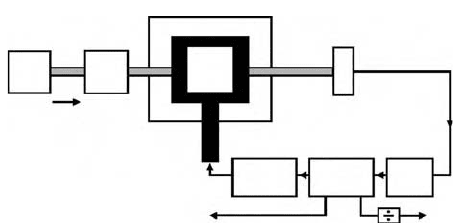
18-12 Mechatronic Systems, Sensors, and Actuators
or changes in the quartz material or crystal structure. A high quality OCXO might age at a rate of <5 ×
10
−9
per year, while a TCXO might age 100 times faster.
Due to aging and environmental factors such as temperature and vibration, it is hard to keep even the
best quartz oscillators within 1 × 10
−10
of their nominal frequency without constant adjustment. For this
reason, atomic oscillators are used for applications that require better long-term accuracy and stability
[4,13,14].
18.3.2 Rubidium Oscillators
Rubidium oscillators are the lowest priced members of the atomic oscillator family. They operate at
6,834,682,608 Hz, the resonance frequency of the rubidium atom (
87
Rb), and use the rubidium frequency
to control the frequency of a quartz oscillator. A microwave signal derived from the crystal oscillator is
applied to the
87
Rb vapor within a cell, forcing the atoms into a particular energy state. An optical beam
is then pumped into the cell and is absorbed by the atoms as it forces them into a separate energy state.
A photo cell detector measures how much of the beam is absorbed, and its output is used to tune a
quartz oscillator to a frequency that maximizes the amount of light absorption. The quartz oscillator is
then locked to the resonance frequency of rubidium, and standard frequencies are derived from the
quartz oscillator and provided as outputs (Figure 18.11).
Rubidium oscillators continue to get smaller and less expensive, and offer perhaps the best price-to-
performance ratio of any oscillator. Their long-term stability is much better than that of a quartz oscillator
and they are also smaller, more reliable, and less expensive than cesium oscillators.
The Q of a rubidium oscillator is about 10
7
. The shifts in the resonance frequency are due mainly to
collisions of the rubidium atoms with other gas molecules. These shifts limit the long-term stability.
Stability (
σ
y
(
τ
), at
τ
= 1 s) is typically 1 × 10
−11
, and about 1 × 10
−12
at 1 day. The frequency offset of a
rubidium oscillator ranges from 5 × 10
−10
to 5 × 10
−12
after a warm-up period of a few minutes or hours,
so they meet the accuracy requirements of most applications without adjustment.
18.3.3 Cesium Oscillators
Cesium oscillators are primary frequency standards since the SI second is defined from the resonance
frequency of the cesium atom (
133
Cs), which is 9,192,631,770 Hz. A properly working cesium oscillator
should be close to its nominal frequency without adjustment, and there should be no change in frequency
due to aging.
Commercially available oscillators use cesium beam technology. Inside a cesium oscillator,
133
Cs atoms
are heated to a gas in an oven. Atoms from the gas leave the oven in a high-velocity beam that travels
through a vacuum tube toward a pair of magnets. The magnets serve as a gate that allows only atoms of
a particular magnetic energy state to pass into a microwave cavity, where they are exposed to a microwave
FIGURE 18.11 Rubidium oscillator.
6 834 682 608 Hz
5 MHz
1 pps
Servo
feedback
Quartz
oscillator
Frequency
synthesizer
Rb-87
buffer
gas
Photo cell
detector
Shielded cavity
Rb-85
buffer gas
Rubidium
lamp
Optical path
9258_C018.fm Page 12 Tuesday, October 2, 2007 1:22 AM
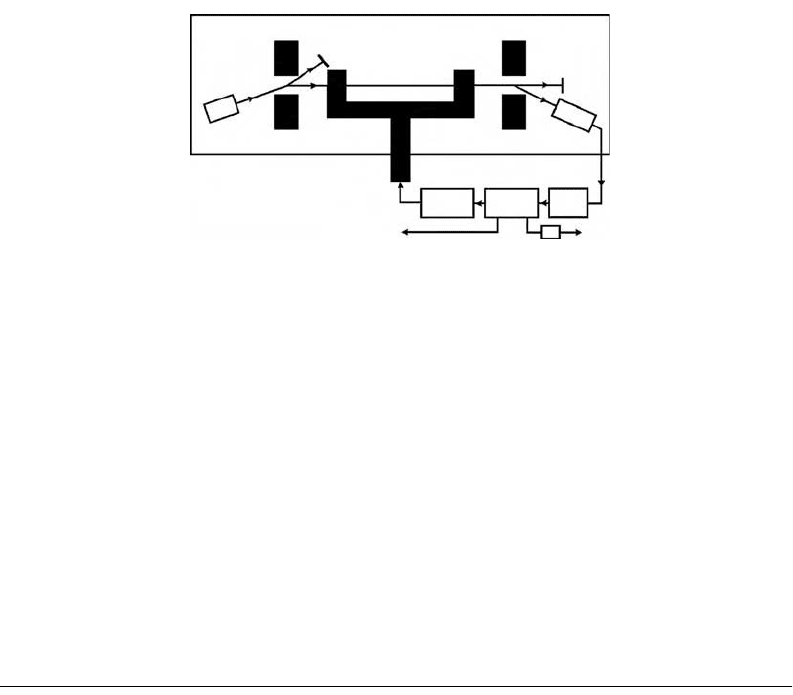
Fundamentals of Time and Frequency 18-13
frequency derived from a quartz oscillator. If the microwave frequency matches the resonance frequency
of cesium, the cesium atoms change their magnetic energy state.
The atomic beam then passes through another magnetic gate near the end of the tube. Those atoms
that changed their energy state while passing through the microwave cavity are allowed to proceed to a
detector at the end of the tube. Atoms that did not change state are deflected away from the detector.
The detector produces a feedback signal that continually tunes the quartz oscillator in a way that
maximizes the number of state changes so that the greatest number of atoms reaches the detector.
Standard output frequencies are derived from the locked quartz oscillator (Figure 18.12).
The Q of a commercial cesium standard is a few parts in 10
8
. The beam tube is typically <0.5 m in
length, and the atoms travel at velocities of >100 m/s inside the tube. This limits the observation time
to a few milliseconds, and the resonance width to a few hundred hertz. Stability (
σ
y
(
τ
), at
τ
= 1 s) is
typically 5 × 10
−12
and reaches a noise floor near 1 × 10
−14
at about 1 day, extending out to weeks or
months. The frequency offset is typically near 1 × 10
−12
after a warm-up period of 30 min.
18.4 Time and Frequency Transfer
Many applications require clocks or oscillators at different locations to be set to the same time (synchro-
nization), or the same frequency (syntonization). Time and frequency transfer techniques are used to
compare and adjust clocks and oscillators at different locations. Time and frequency transfer can be as
simple as setting your wristwatch to an audio time signal, or as complex as controlling the frequency of
oscillators in a network to parts in 10
13
.
Time and frequency transfer can use signals broadcast through many different media, including coaxial
cables, optical fiber, radio signals (at numerous places in the radio spectrum), telephone lines, and the
Internet. Synchronization requires both an on-time pulse and a time code. Syntonization requires extract-
ing a stable frequency from the broadcast. The frequency can come from the carrier itself, or from a time
code or other information modulated onto the carrier.
This section discusses both the fundamentals of time and frequency transfer and the radio signals used
as calibration references. Table 18.6 provides a summary.
18.4.1 Fundamentals of Time and Frequency Transfer
Signals used for time and frequency transfer are generally referenced to atomic oscillators that are steered
to agree as closely as possible with UTC. Information is sent from a transmitter (A) to a receiver (B) and
is delayed by
τ
ab
, commonly called the path delay (Figure 18.13).
To illustrate path delay, consider a radio signal broadcast over a path 1000 km long. Since radio signals
travel at the speed of light (∼3.3 µs/km), we can calibrate the path by applying a 3.3-ms correction to our
FIGURE 18.12 Cesium beam oscillator.
9 192 631 770 Hz
5 MHz
1 pps
÷
Servo
feedback
Quartz
oscillator
Frequency
synthesizer
Microwave
interrogation
cavity
State detection
magnets
Vacuum cavity
Detector
Getter
Getter
State selection
magnets
Cesium
oven
9258_C018.fm Page 13 Tuesday, October 2, 2007 1:22 AM
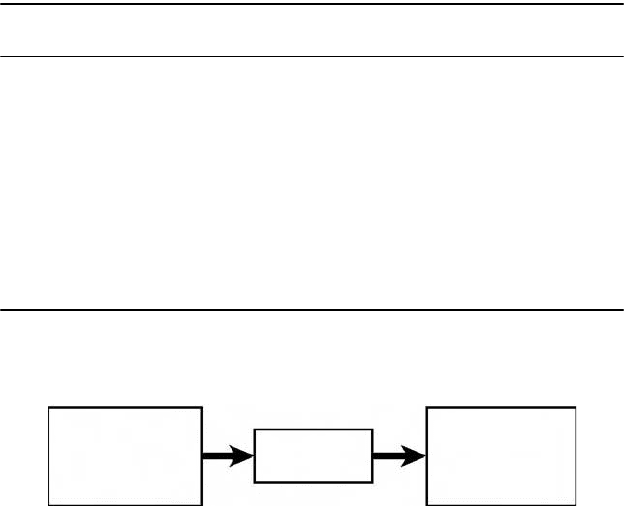
18-14 Mechatronic Systems, Sensors, and Actuators
measurement. Of course, for many applications the path delay is simply ignored. For example, if our
goal is simply to synchronize a computer clock within 1 s of UTC, there is no need to worry about a
100-ms path delay through a network. And, of course, path delay is not important to frequency transfer
systems, since on-time pulses are not required. Instead, frequency transfer requires only a stable path
where the delays remain relatively constant.
More sophisticated transfer systems estimate and remove all or part of the path delay. This is usually
done in one of two ways. The first way is to estimate
τ
ab
and send the time out early by this amount.
For example, if
τ
ab
is at least 20 ms for all users, the time can be sent 20 ms early. This advancement of
the timing signal removes at least some of the delay for all users.
A better technique is to compute
τ
ab
and to apply a correction to the received signal. A correction for
τ
ab
can be computed if the position of both the transmitter and receiver are known. If the transmitter is
stationary, a constant can be used for the transmitter position. If the transmitter is moving (a satellite,
for example) it must broadcast its position in addition to broadcasting time. The Global Positioning
System (GPS) provides the best of both worlds—each GPS satellite broadcasts its position and the receiver
can use coordinates from multiple satellites to compute its own position.
The transmitted information often includes a time code so that a clock can be set to the correct time-
of-day. Most time codes contain the UTC hour, minute, and second; the month, day, and year; and
advance warning of daylight saving time and leap seconds.
18.4.2 Radio Time and Frequency Transfer Signals
There are many types of radio receivers designed to receive time and frequency signals. Some are designed
primarily to produce time-of-day information or an on-time pulse, others are designed to output standard
frequencies, and some can be used for both time and frequency transfer. The following sections look at
three types of time and frequency radio signals that distribute UTC—high frequency (HF), low frequency
(LF), and GPS satellite signals.
TABLE 18.6 Summary of Time and Frequency Transfer Signals and Methods
Signal or Link Receiving Equipment
Time Uncertainty
(24 h)
Frequency
Uncertainty (24 h)
Dial-up computer time
service
Computer, client
software, modem,
and phone line
<15 ms Not recommended
for frequency
measurements
Internet time service Computer, client
software, and
Internet connection
<1 s Not recommended
for frequency
measurements
HF radio (3–30 MHz) HF receiver and
antenna
1–20 ms 10
−6
–10
−9
LF radio (30–300 kHz) LF receiver and
antenna
1–100
µ
s10
−10
–10
−12
Global positioning system
(GPS)
GPS receiver antenna <20 ns <2 × 10
−13
FIGURE 18.13 One-way time and frequency transfer.
Transmitter
A
Receiver
B
Medium
ab
τ
9258_C018.fm Page 14 Tuesday, October 2, 2007 1:22 AM
Fundamentals of Time and Frequency 18-15
18.4.2.1 HF Radio Signals (Including WWV and WWVH)
High frequency radio broadcasts occupy the radio spectrum from 3 to 30 MHz. These signals are
commonly used for time and frequency transfer at moderate performance levels. Some HF broadcasts
provide audio time announcements and digital time codes. Other broadcasts simply provide a carrier
frequency for use as a reference.
HF time and frequency stations include NIST radio stations WWV and WWVH. WWV is located near
Fort Collins, Colorado, and WWVH is on the island of Kauai, Hawaii. Both stations broadcast continuous
time and frequency signals on 2.5, 5, 10, and 15 MHz, and WWV also broadcasts on 20 MHz. All
frequencies broadcast the same program, and at least one frequency should be usable at all times. The
stations can also be heard by telephone; dial (303) 499-7111 for WWV or (808) 335-4363 for WWVH.
WWV and WWVH signals can be used in one of three modes:
•
The audio portion of the broadcast includes seconds pulses or ticks, standard audio frequencies,
and voice announcements of the UTC hour and minute. WWV uses a male voice, and WWVH
uses a female voice.
•
A binary time code is sent on a 100 Hz subcarrier at a rate of 1 bit per second. The time code
contains the hour, minute, second, year, day of year, leap second and Daylight Saving Time (DST)
indicators, and a UT1 correction. This code can be read and displayed by radio clocks.
•
The carrier frequency can be used as a reference for the calibration of oscillators. This is done
most often with the 5 and 10 MHz carrier signals, since they match the output frequencies of
standard oscillators.
The time broadcast by WWV and WWVH will be late when it arrives at the user’s location. The time
offset depends upon the receiver’s distance from the transmitter, but should be <15 ms in the continental
United States. A good estimate of the time offset requires knowledge of HF radio propagation. Most
users receive a signal that has traveled up to the ionosphere and was then reflected back to earth. Since
the height of the ionosphere changes throughout the day, the path delay also changes. Path delay variations
limit the received frequency uncertainty to parts in 10
9
when averaged for 1 day.
HF radio stations such as WWV and WWVH are useful for low level applications, such as the manual
synchronization of analog and digital clocks, simple frequency calibrations, and calibrations of stop
watches and timers. However, LF and GPS signals are better choices for more demanding applica-
tions [2,7,15].
18.4.2.2 LF Radio Signals (Including WWVB)
Before the advent of satellites, low frequency signals were the method of choice for time and frequency
transfer. While the use of LF signals has diminished in the laboratory, they still have two major advan-
tages—they can often be received indoors without an external antenna and several stations broadcast a
time code. This makes them ideal for many consumer electronic products that display time-of-day
information.
Many time and frequency stations operate in the LF band from 30 to 300 kHz (Table 18.7). The
performance of the received signal is influenced by the path length and signal strength. Path length is
important because the signal is divided into ground wave and sky wave. The ground wave signal is more
stable. Since it travels the shortest path between the transmitter and receiver, it arrives first and its path
delay is much easier to estimate. The sky wave is reflected from the ionosphere and produces results
similar to those obtained with HF reception. Short paths make it possible to continuously track the
ground wave. Longer paths produce a mixture of sky wave and ground wave. And over very long paths,
only sky wave reception is possible.
Signal strength is also important. If the signal is weak, the receiver might search for a new cycle of the
carrier to track. Each time the receiver adjusts its tracking point by one cycle, it introduces a phase step
equal to the period of the carrier. For example, a cycle slip on a 60 kHz carrier introduces a 16.67
µ
s
phase step. However, a strong ground wave signal can produce very good results. An LF receiver that
9258_C018.fm Page 15 Tuesday, October 2, 2007 1:22 AM
